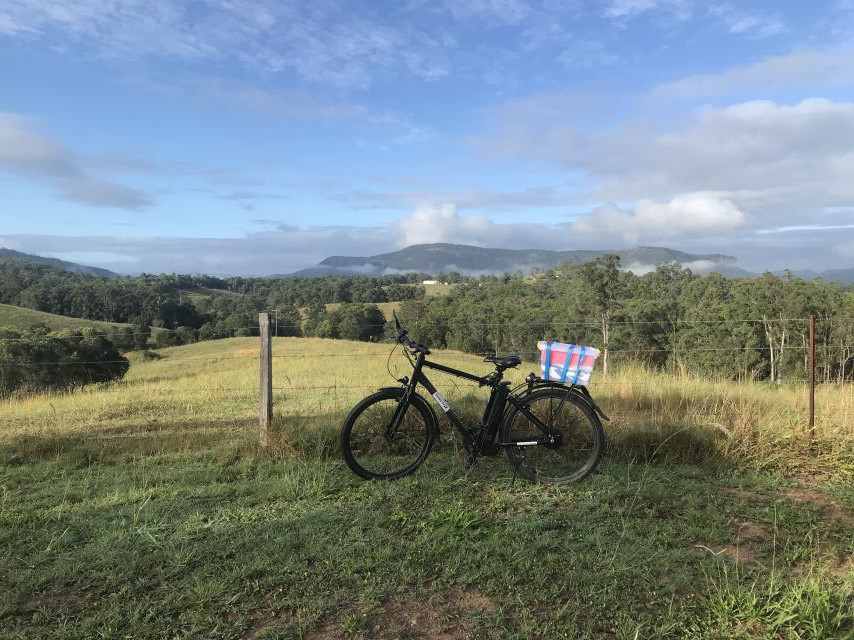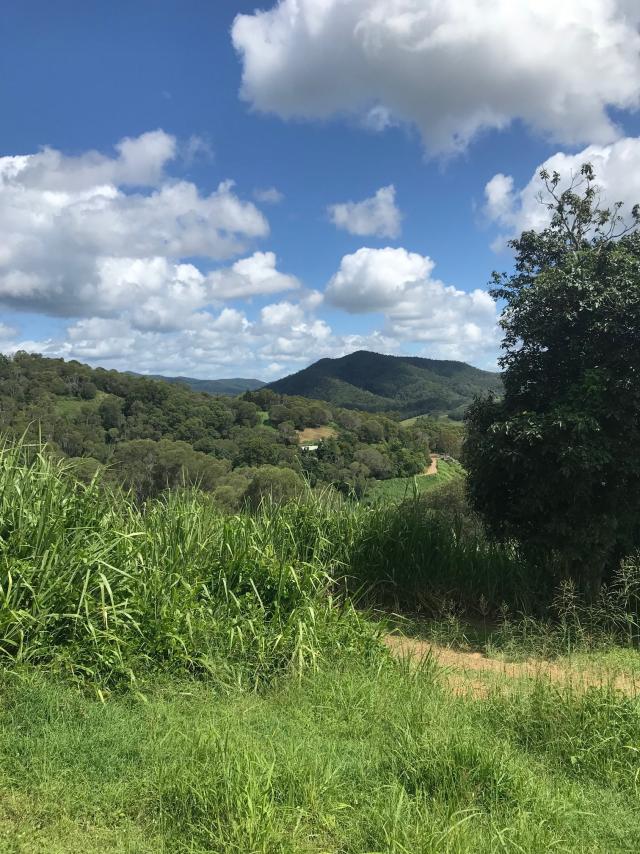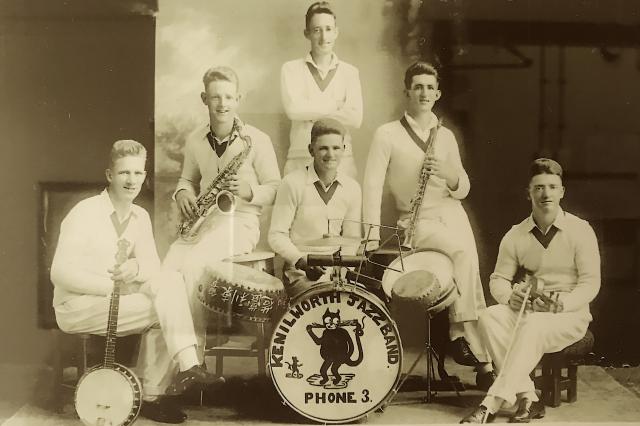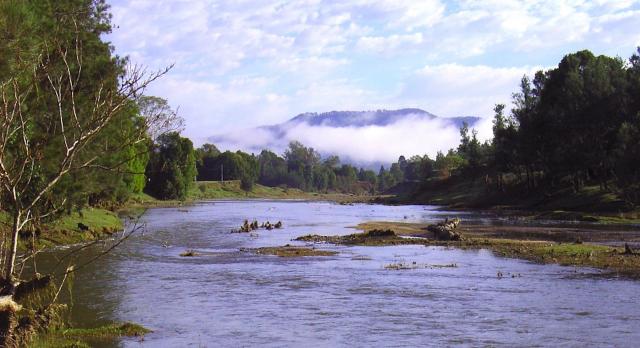Until within five or six years these lands attracted but little attention. It was known that they were extremely fertile, but it was thought that the cost and uncertainty of reclaiming them were too great to warrant the enterprise. Of late, however, they have been rapidly bought up by capitalists, and their sagacity has been justified by the results on those tracts which have been reclaimed. These Tule lands are simply deposits of muck… The state has sold them for one dollar per acre. – Charles Nordhoff, 1874, quoted by Joan Didion in Where I Was From (2003)
I was flipping through the pages of Didion’s wonderful little California memoir, while I gave my e-bike a battery charge in Eumundi, sipping a coffee in the autumn morning sun before resuming my ride out into the Mary Valley.
Didion was writing about the Sacramento River and its broad, flat valley which would flood (or experience “high water” as the settlers called it) every spring and often remain that way until late in the summer when the run-off from the Sierra Nevada’s snowy peaks would finally drain into San Francisco Bay.
But the parallels with the Mary are many, with settlers rolling down from the Rockies in wagon trains from 1850 to make their lives in the New West thanks to the gold rush, or more likely to the fertile soil of cheap land, prepared to trade off the annual hardships, sickness and death of the high water for the hope of prosperity. The point of difference being that their pain ended in the 20th century when California broke every environmental rule in the book to create what Didion calls an “entirely artificial environment” of river-diverting levees, canals and dams that is now what the New York Times has referred to as “our greatest food resource”. The certainty of high water endures in the Mary Valley.
A trickle of hardy settlers fought their way down the Conondale Range to take up runs in the 1850s and early ‘60s, but, as in California, gold accelerated the process, with the 1867 Gympie gold rush creating a two-way flow of people taking the rough Mary River tracks to Gympie and the diggings, and coming back to the valley to try agriculture when they failed to strike the motherlode.
I knew a little of this history and wanted to learn more, but I also wanted to get a feel for the land and its spirit that you can’t get inside a car, so I continued my pedal west on this rare glorious May morning, past Belli Creek and onto the river plains and the dramatic bluffs that punctuate them.
As well as revisiting Didion, I’d been dipping into a small volume called A Strong Brown God, in which the Maleny-based writer Steven Lang waxes lyrical about a walk he did along the Mary from source to mouth 30 years ago. I’ve left my run a bit late for that, but I’m hoping that even at my advanced age I can pick up on some of the insights he gained about the land as well as the people by self-propelling along the backroads of the valley for a few days.
But it’s possible the people who wave as they pass on the morning school run, or while checking their fences on a quad, just wonder what this old, white-haired galoot is trying to prove. You don’t have to go far out into the valley to be in the zone of people who work so physically hard they think exercise is frivolous, and when I nearly get taken out by a quarry truck as it turns into Moy Pocket Road at Gheerulla, I’m tempted to add dangerous as well.
But the odd encounter with a quarry truck was nothing compared with the trials, tribulations and brushes with mortality that the early settlers faced on a daily basis as they guided their bullock teams down the range and followed the Mary downstream to Kenilworth Run and the handful of other selections around it, looking for work or for a five-year lease on a run of their own.
The trickle of settlers increased after James Nash discovered gold at Gympie in 1867, but it wasn’t until the late 1880s when the Land Act of 1884 carved up the biggest runs and ushered in the era of Closer Settlement, that it became a stream.
In 1891 a group of young men from the Enoggera area of Brisbane set out to find suitable land in the Mary Valley to build small farms, travelling by train to Yandina, then on foot across rough country to Belli and onto the Mary where it was joined by Yahoo Creek, now known as Gheerulla, about six kilometres from what is now the township of Kenilworth. The land was everything they’d hoped for, so Ned Pickering, Jack McGinn and Dick Sims built a slab hut and started clearing the land to fence off separate holdings where they would grow maize and potatoes.
“Richard Sims was my grandfather,” declares Lenore Meldrum, as we settle in for a chat in her crowded office at the Kenilworth Historical Museum at the edge of town. Although the museum opens only on Sundays, Lenore, who has managed it for the past 20 years, has made a special trip in from the Sims family estate to see me, so I’ve pedaled up the hill from the pub at pace and arrive out of puff, which the friendly, laughing woman finds hilarious. Well, born and bred in the valley and known as a walking encyclopedia of the hard years, she’s earned the right.
Reflecting on the fact that the Gympie Times had labelled these pioneering farmer-settlers “rational socialists”, Lenore explains: “My grandfather and his neighbours were socialists in the purest form. When they wanted to take crops to market at the Gympie goldfields, one farmer would take three days off, take his workers and his sons and they’d transport the goods into Gympie, then handle the sales. The other farmers would pick up all his work on his property.
“When they decided to build a school in 1899 a neighbour donated the land and my grandfather donated a tree which was cut up and the school was built. That was how they survived in those days.”
But the rational socialists would have to take sharing even further when, just two years into their tenure, the record floods of 1893 wiped out their crops and a year’s income, and a depression and further flooding in 1898 meant that they lost three years’ income out of seven.
“Now instead of each farmer deciding what he was going to do to survive, they held a meeting and the community decided what they’d do to earn an income,” Lenore said.
“They decided to go into dairying and pig-raising but they couldn’t afford a cream separator each so they bought a communal one which was kept at my grandfather’s farm, which was centrally located and all the farmers would bring their milk in and when it was separated it was sent by packhorse to Eumundi to get on the train to go to the butter factory in Brisbane.
“They went into pig raising because you could buy a sow in litter quite cheaply, but again each of them couldn’t afford a stud boar, so they bought one communally and he was transported from farm to farm, the happiest pig in Queensland!” Lenore roars with laughter.
“This is how the community thrived, then prospered.”
In those days the Mary Valley was remote and lawless, but the moral code of the Gheerulla settlers was strong.
“They were all devout Anglicans and it was their nature to abide by the law, but really it was controlled by family. The first three selectors at Yahoo Creek in 1891 were single when they arrived, but very soon grandfather Richard Littleworth Sims had married Edward Pickering’s sister, Hannah, Edward Pickering married John McGinn’s sister, John McGinn married Edward’s cousin Rye, and so on. All the young men brought their wives to live in very basic slab huts and went on to have children very quickly,” Lenore said.
“The other part of their code was a respect and empathy for the local Aboriginal people, the Kabi Kabi. When they were removing them to go to Cherbourg my grandfather wrote to the Queensland government with the request that the families living on his property be allowed to stay. It was refused. And, you know, on their walkabouts they would always stop and have a meal at my grandparents’ place, and the ladies would bring their babies to show grandma.”
By the 1920s the town of Kenilworth was finally taking shape, with the large Sims family front and centre in its commerce.
Arthur Tanner, who opened the first store in 1924, married eldest daughter Winnie Sims, and later went into business with two of Winnie’s brother in Sims Brothers Motor Garage, just along the street from Sims Brothers Transport.
Lenore’s dad, Bert, inherited the family farm and his wife ran the town telephone exchange from the homestead, while Bert found the time to also become a long-serving Maroochy councillor and run the town’s Saturday night picture show.
There were many other Kenilworth pioneer families, but the Sims lineage of more than 130 years is impeccable, not that it was without interruption in Lenore’s case. She left home to go to boarding school in 1957, and a storied career in education, psychology and medical science, not to mention her marriage to banker Blair Meldrum, kept her away until she and Blair retired to the family home more than 40 years later.
Around the turn of the century Lenore took over the management of the historical museum and its expanding exhibition rooms, while Blair became a dedicated committee man and produced a new edition of local history, Hinka-Booma to Kenilworth, before his untimely death.
Nearing 80, Lenore has lost none of her boundless energy nor her passion for the history of the valley.
We’ve talked for hours, but I’ve got to get on the road for Imbil, with a few stops along the way. There’s just time for her to see me off and raise another chuckle at the sight of a fellow septuagenarian donning his hi-vis vest and taking off down the hill on the e-bike, his plastic box of chargers and history books rattling on the luggage rack.
Next week, Imbil and beyond, and the story of the flood.











